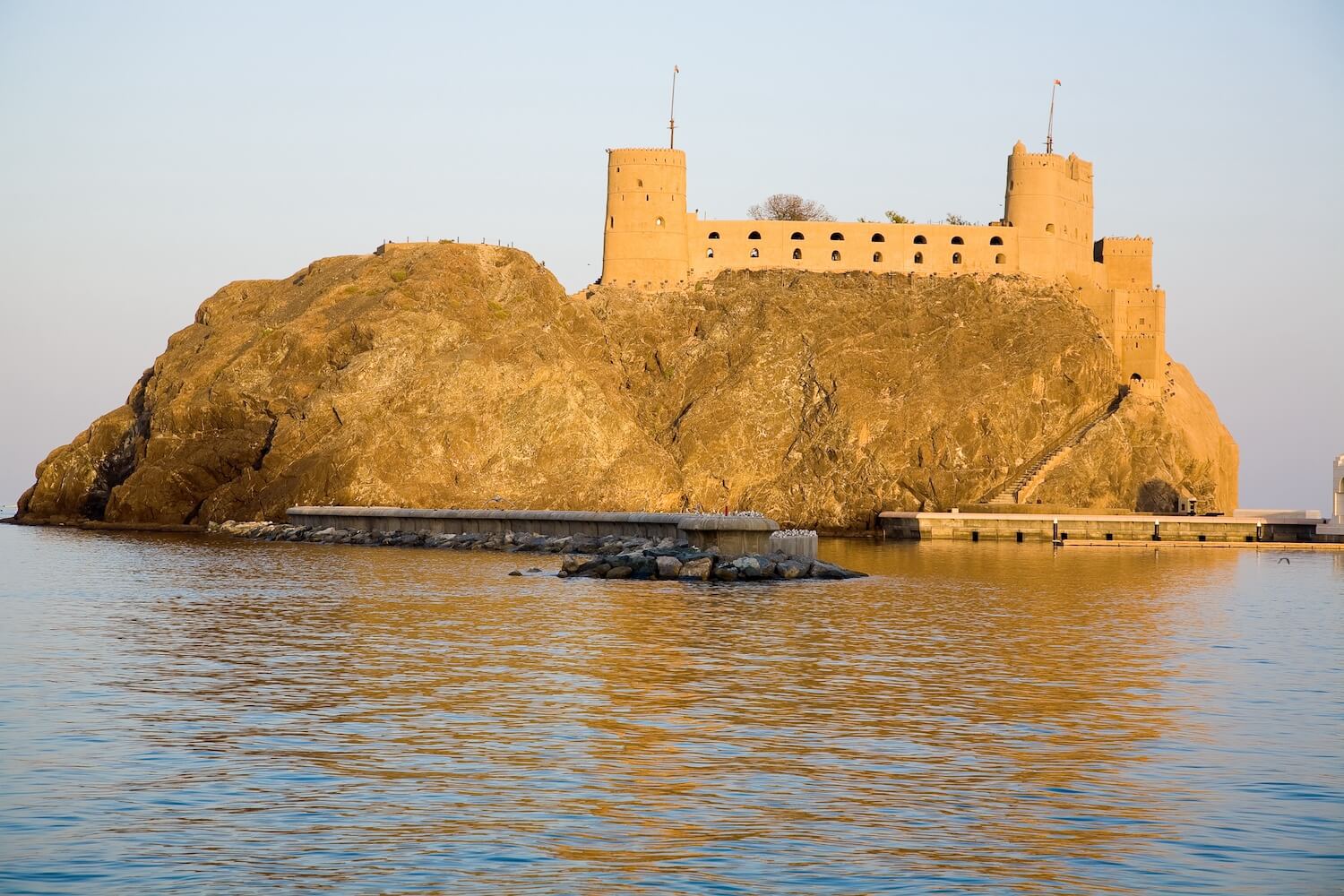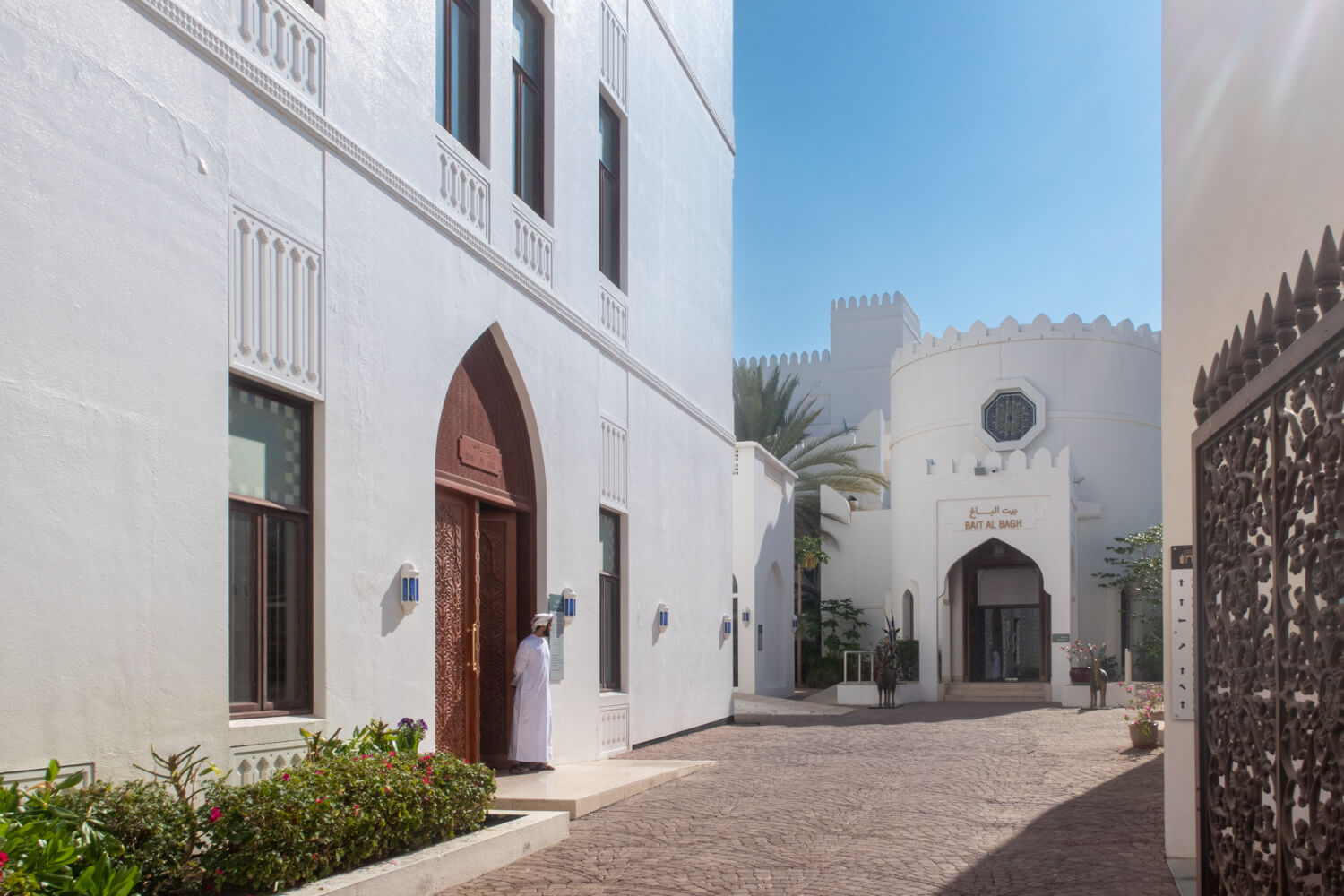Al Jalali Fort, standing proudly on the rocky hills of Muscat, Oman, is an enduring symbol of the country’s rich history and strategic significance. This monumental fort, originally built by the Portuguese in the 16th century, has witnessed centuries of transformation, from a military stronghold to a symbol of national heritage. It is one of the two forts—along with Al Mirani Fort—that played a key role in defending Muscat’s coastline against various threats throughout history.

The History of Al Jalali Fort, Muscat
Origins and Historical Significance
Al Jalali Fort was constructed by the Portuguese as part of their efforts to control the trade routes in the Arabian Gulf and to safeguard their presence in Oman during the 1500s. The fort’s location, perched on a rocky hill overlooking Muscat’s natural harbor, was strategically chosen to give the Portuguese a commanding view of the sea and to guard against potential naval threats. It was designed to be a formidable defense point, equipped to deter Ottoman forces and protect against local uprisings.
In the early 17th century, the fort’s control shifted when the Portuguese were expelled from Oman by Sultan bin Saif Al Ya’rubi, a leader of the Omani people. This marked a significant turning point in the country’s history, as the fort came under Omani control and became an important symbol of local independence. Over the following centuries, the fort changed hands multiple times, but its role in defending Muscat and its importance to Omani sovereignty remained central.
Transformation Over the Centuries
Unlike many other forts, which were abandoned once their military function had passed, Al Jalali Fort remained in active use throughout history. In the 20th century, after its military significance had waned, it was repurposed as a prison. The fort housed political prisoners and prominent individuals, adding a layer of complexity to its long history.
In recent years, the Omani government undertook efforts to restore Al Jalali Fort, preserving its historical and architectural significance. The fort is now a heritage museum, offering visitors a glimpse into Oman’s military and cultural past. Although it is not open to the public for regular tours, the fort continues to serve as an important venue for state functions and official ceremonies, playing a role in Oman’s modern political and cultural landscape.

A Deep Dive into Al Jalali Fort’s Structure
Al Jalali Fort’s architectural design is a testament to the ingenuity and strategic thinking of its creators. Its commanding position, design features, and defensive innovations reflect the fort’s purpose as both a military stronghold and a symbol of power.
Strategic Location and Design
The fort’s most striking feature is its location. Perched high on a rocky hill overlooking the Gulf of Oman, Al Jalali Fort offers a panoramic view of Muscat’s old harbor. This elevated position gave the fort’s defenders an unparalleled vantage point, allowing them to spot potential threats long before they could approach the fort. The steep staircase carved into the rock that leads to the fort only adds to its imposing nature, making it difficult for invaders to access the fort’s interior.
The design of Al Jalali Fort is a fusion of Portuguese and Omani architectural styles, which blend seamlessly to create a unique and formidable structure. The fort’s high stone walls, battlements, and strategically placed watchtowers are indicative of its military purpose. Arched gateways, hidden chambers, and narrow corridors lend an air of mystery to the fort, contributing to its strategic defenses and mystique. The fort’s design reflects the dual need for both practical military defense and architectural grandeur, making it not only a fortress but also a symbol of strength and power.
Defensive Features and Military Innovations
Al Jalali Fort was designed with several military innovations that ensured its strength and resilience. The fort’s thick stone walls were capable of withstanding cannon fire, providing ample protection for its occupants. Underground storage rooms ensured that the fort had sufficient supplies of food, water, and ammunition to withstand prolonged sieges, a key feature for any military stronghold.
Rainwater collection systems were also integrated into the fort’s design, ensuring that the inhabitants had a steady supply of water, even during times of siege. These systems, along with secret tunnels that led out of the fort, gave the defenders multiple escape routes and ways to maintain communication with the outside world during periods of conflict.
The fort underwent several renovations over the centuries, as its function evolved. While much of its original design remains intact, modifications were made to modernize the structure for its changing purposes. Despite these updates, the fort has retained much of its historical charm and continues to stand as a remarkable example of Omani and Portuguese architectural ingenuity.
Al Jalali Fort remains a powerful reminder of Oman’s past, reflecting both its strategic significance in historical conflicts and its lasting role in the nation’s cultural and political identity. Its unique architectural features and fascinating history make it a must-visit destination for anyone interested in exploring the rich heritage of Muscat and Oman.

Cultural and Tourist Significance of Al Jalali Fort
Al Jalali Fort is not only a remarkable historical and architectural landmark but also a vital part of Oman’s cultural heritage. Its strategic role in defending Muscat and symbolizing the resilience of the Omani people has cemented its place in the nation’s identity. The fort, although not accessible to the public for interior tours, continues to be a significant point of interest for both tourists and locals alike.
Role in Omani Heritage
As one of the most iconic structures in Muscat, Al Jalali Fort holds deep historical significance within Oman. The fort stands as a testament to the Omani people’s dedication to protecting their land and sovereignty. Its historical role in defending against invasions, particularly by the Portuguese and later regional conflicts, makes it a symbol of national pride.
Artifacts housed within the fort, including ancient weapons, maps, and documents, showcase Oman’s military prowess and provide visitors with a glimpse into the nation’s long and proud history of defense and resilience. These items, alongside the fort’s physical presence, serve as a reminder of the strength and determination that shaped Oman’s identity over the centuries.
Despite its restricted access to the public, Al Jalali Fort remains an integral part of Oman’s historical narrative. The fort’s exterior can still be admired, and visitors can appreciate its imposing structure and strategic location, understanding its pivotal role in Oman’s past.
Al Jalali Fort in Modern Tourism
While Al Jalali Fort is not open for tours, its visual impact is undeniable. Situated along Muscat’s scenic waterfront, it contributes significantly to the city’s historical landscape. Al Jalali, alongside its twin fort, Al Mirani Fort, and the Sultan’s Palace, creates an awe-inspiring backdrop for anyone visiting the area. The majestic sight of these forts overlooking the water presents perfect opportunities for photography, allowing tourists to capture the beauty and grandeur of these centuries-old structures.
Many guided tours in Muscat include stops at the forts, even though they are not accessible to explore from within. These tours provide valuable historical insights into the importance of the forts, making them more than just visual landmarks but also key pieces of the historical fabric of Muscat. For tourists looking for more cultural immersion, these tours often also include visits to nearby attractions such as the Mutrah Souq, the National Museum of Oman, and the Royal Opera House, which deepen the understanding of Oman’s rich cultural and historical heritage.

How to Visit Al Jalali Fort and Nearby Attractions
Best Viewing Spots and Photography Tips
Since Al Jalali Fort is closed to the public, the best way to enjoy its splendor is to find the perfect viewing spots in the surrounding areas. Here are a few prime locations for capturing the fort’s majesty:
- Al Alam Palace: Situated nearby, Al Alam Palace provides a spectacular view of both Al Jalali and Al Mirani Forts. The view is particularly striking at sunset when the forts and the surrounding area are bathed in golden light.
- Mutrah Corniche: This scenic waterfront promenade offers excellent vantage points to photograph Al Jalali Fort. The fort, with its dramatic hillside location, creates a striking contrast against the serene waters of the Gulf of Oman, making it a great spot for both daytime and evening photos.
- Boat Tours: For those wanting a closer perspective, some guided boat tours offer views of the forts from the water. This gives visitors the unique opportunity to see Al Jalali from a different angle, showcasing the fort’s design against the backdrop of Muscat’s coastline.
Exploring Muscat’s Historical Landscape
A visit to Al Jalali Fort should be part of a larger exploration of Muscat’s historical sites. For those interested in learning more about Oman’s rich history, here are some must-see attractions:
- Al Mirani Fort: As the twin fort of Al Jalali, Al Mirani Fort was also constructed by the Portuguese and shares a similar history. Located nearby, it’s a great complement to a visit to Al Jalali, giving visitors a deeper understanding of the fortifications in Muscat.
- The National Museum of Oman: A short distance from the forts, this museum offers an in-depth look at Oman’s history, including exhibitions on the nation’s maritime heritage, military history, and cultural traditions. It provides context to the historical role of forts like Al Jalali in Oman’s defense.
- Bait Al Zubair Museum: This museum focuses on Oman’s rich culture and traditions. Located in Muscat, Bait Al Zubair is an ideal place to learn more about the country’s heritage, offering exhibits on traditional Omani crafts, clothing, and daily life, which complements the historical significance of Al Jalali Fort.



0 Comment